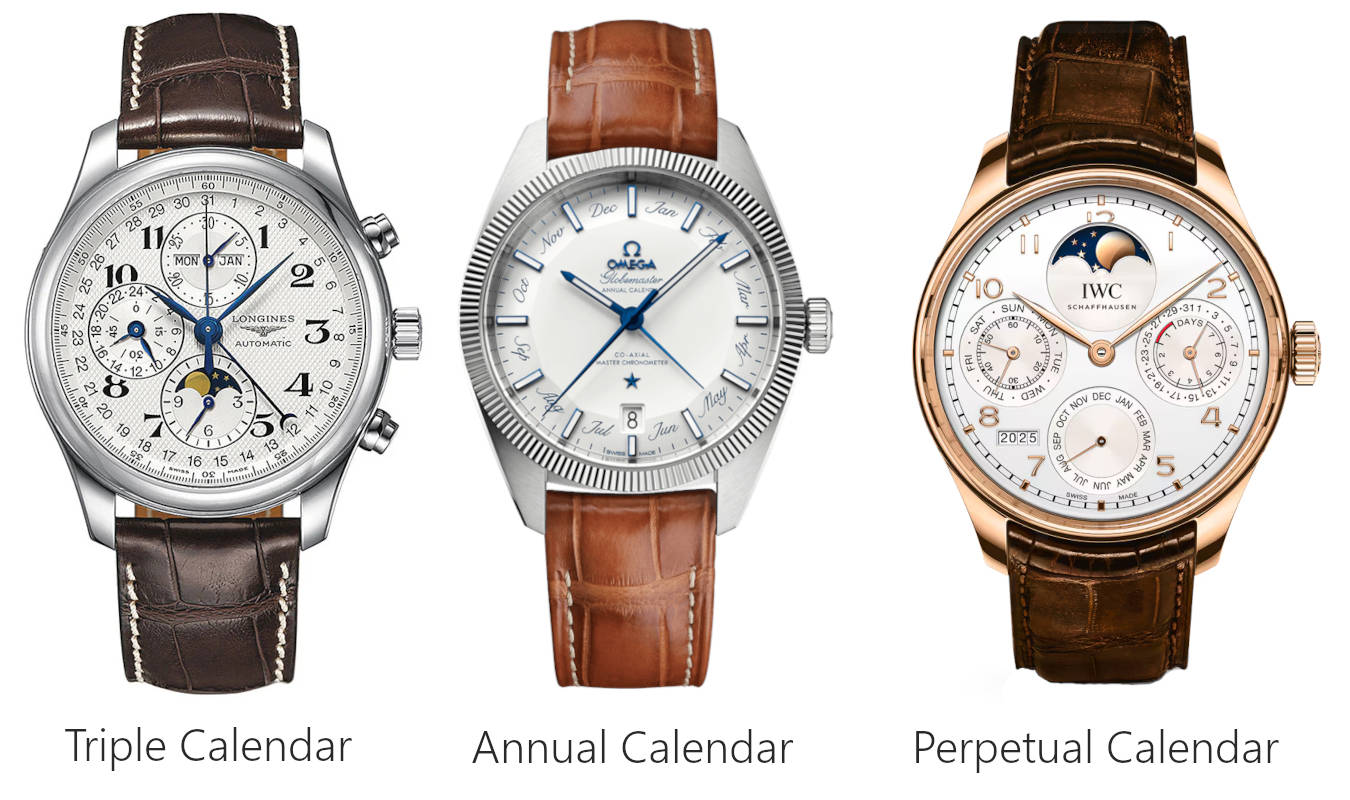- 1. Date Display – The Foundation of Calendar Watches
- 2. Day-Date – Twice the Insight at a Glance
- 3. Triple Calendar (Complete Calendar) – A Symphony of Time
- 4. Annual Calendar – Smart Enough to Know the Month
- 5. Perpetual Calendar – The Genius of Mechanical Timekeeping
- 6. Easter Date Indicator – A Rare Dance of Astronomy and Faith
- 7. Equation of Time – Where Astronomy Meets Timekeeping
- Frequently Asked Questions About Watch Calendar Complications
- What is a watch complication?
- What is the most common calendar complication in watches?
- What’s the difference between an annual and a perpetual calendar?
- Why are some calendar watches so expensive?
- Are there affordable watches with calendar complications?
- What is the rarest calendar complication?
- What are some luxury watches with advanced calendar complications?
- Conclusion: Time Is More Than Just Hours and Minutes
Watch complications aren’t just functional—they’re a glimpse into the soul of horology. Among the most practical and fascinating are calendar-based complications. From basic date displays to the engineering marvel of perpetual calendars, this guide breaks them all down—and recommends some of the best (and most affordable) watches featuring each.
1. Date Display – The Foundation of Calendar Watches
The date display complication is where horological complexity meets everyday practicality. It’s one of the most widespread and essential features found in modern wristwatches. Usually positioned at 3 o’clock or 6 o’clock, this small window reveals the current day of the month—yet behind its simplicity lies a remarkable story of innovation.
A Brief History
The first wristwatch to feature a date complication was the Rolex Datejust, introduced in 1945. It was revolutionary at the time: a self-winding chronometer wristwatch that automatically changed the date at midnight. This single feature transformed the wristwatch from a time-telling tool into a personal calendar, paving the way for a new era of functional luxury.
How It Works
A disc printed with numbers from 1 to 31 sits just beneath the dial. Once every 24 hours, a mechanical gear advances the disc by one position. While it may seem simple, this mechanism must be perfectly aligned and precisely timed—a true testament to mechanical engineering.
Why It Matters
In the digital age, we’re surrounded by smartphones and smartwatches, but there's still something timeless about glancing at your wrist for the date. For professionals, travelers, and collectors alike, a date display adds daily value without overcomplicating the design.
Interesting Fact
Many watches skip the number “4” in favor of a smaller or altered font to make room for the date window at 3 o’clock. It’s a subtle design choice that sparks debate among collectors and designers alike.
Top Watch Pick: Orient Bambino Version 4 FAC08004D0
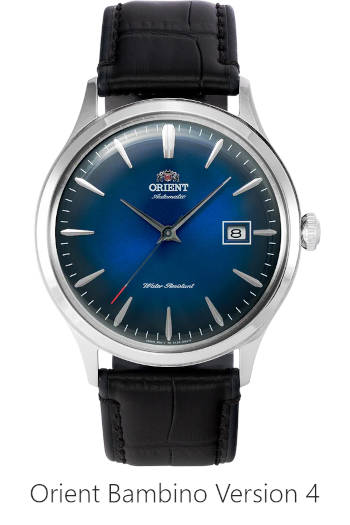
| Store | Link |
|---|---|
| Ebay | Check it out on Ebay |
| Amazon | Check it out on Amazon |
A beautifully balanced dress watch that blends modern performance with vintage style. The Orient Bambino features a clean dial with a simple date window at 3 o’clock, powered by an in-house automatic movement. It’s a reliable, affordable, and stylish introduction to classic mechanical watches—ideal for anyone exploring calendar complications without overwhelming complexity.
2. Day-Date – Twice the Insight at a Glance
The day-date complication is where functionality meets refined utility. It displays both the day of the week and the date of the month—usually in a dual-window format (side-by-side) or stacked vertically. This seemingly small addition adds a big dose of everyday convenience and visual balance to a dial.
A Brief History
The most iconic watch to feature this complication? The legendary Rolex Day-Date, launched in 1956. It was the first wristwatch to spell out the day of the week in full alongside the date—available in 26 languages. Often referred to as the “President’s Watch,” it has graced the wrists of world leaders, CEOs, and celebrities for decades. The model’s influence was so great that the term “Day-Date” became synonymous with prestige in horology.
How It Works
Inside the case, a pair of rotating discs—one for the day, one for the date—are advanced by the watch’s movement. Coordinating these two displays to shift simultaneously at midnight is no small feat and requires precise engineering. In mechanical models, the change can be instantaneous or gradual, depending on the movement.
Why It’s Practical
A day-date watch offers the kind of functionality that suits professionals, travelers, and anyone managing a busy schedule. It delivers just enough information to keep you grounded in time—without overwhelming the dial.
Did You Know?
Some high-end day-date watches let you customize the language of the day display—a rare and personalized feature for polyglots and collectors alike.
Top Watch Pick: Orient RA-AA08
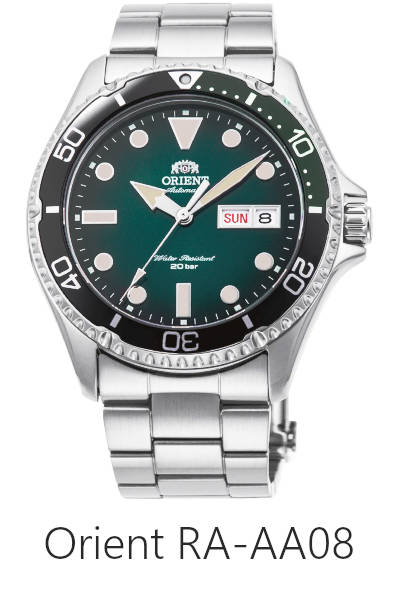
| Store | Link |
|---|---|
| Amazon | Check it out on Amazon |
| Ebay | Check it out on Ebay |
The Orient RA-AA08 is a standout in the Orient lineup, offering a perfect blend of functionality and style. Featuring both day and date displays at the 3 o'clock position, it ensures you stay on schedule with ease. Powered by Orient's reliable F6922 automatic movement, this watch boasts a 40-hour power reserve and manual winding capability. Its 41.8mm stainless steel case, unidirectional rotating bezel, and 200m water resistance make it a versatile choice for everyday wear and adventure.
Luxury Option: Rolex Day-Date 36
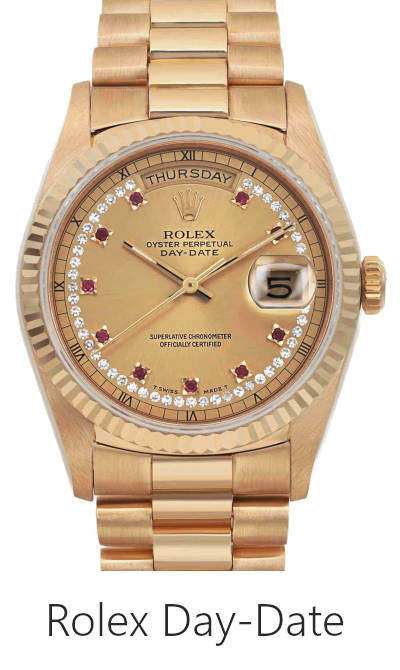
The ultimate expression of calendar complications, the Rolex Day-Date 36 blends horological innovation with elite craftsmanship. Known for its precious metal cases and President bracelet, this model has been worn by U.S. presidents, business moguls, and icons of history. If you’re looking for timeless prestige and perfect execution, this is the definitive day-date watch.
| Store | Link |
|---|---|
| The Luxury Closet | Check it out on The Luxury Closet |
| Ebay | Check it out on Ebay |
3. Triple Calendar (Complete Calendar) – A Symphony of Time
The triple calendar complication, also known as the complete calendar, is where horology begins to show off. It displays the day of the week, the date, and the month—often arranged in an elegant layout that makes the dial come alive with information. This is the point where a watch becomes not just practical, but poetic.
A Brief History
The triple calendar dates back to the mid-20th century, when it became popular in both dress and military watches. One of the most famous early examples is the Omega Cosmic from the 1940s, which combined the full calendar with a moonphase—setting a design precedent that still inspires modern timepieces.
Before digital calendars and smartphones, a complete calendar on your wrist was the ultimate organizational tool, especially for professionals and world travelers.
How It Works
The triple calendar uses three rotating discs inside the watch: one for the day, one for the date, and one for the month. The mechanism must be manually adjusted at the end of months with fewer than 31 days. While this may seem like a chore, many enthusiasts appreciate the interaction—it keeps you in tune with your watch and with time itself.
Why Enthusiasts Love It
The triple calendar hits the sweet spot between complexity and wearability. It offers more information than a day-date, yet remains mechanically approachable. For collectors, it’s often a gateway into more advanced complications like annual or perpetual calendars.
Bonus Appeal
Many triple calendar watches—especially traditional ones—include a moonphase complication, adding a layer of visual charm and astronomical heritage.
Top Watch Pick: Longines Master Collection L2.673.4.78.3

Elegant and exquisitely balanced, the Longines Master Collection Triple Calendar is a masterpiece of Swiss craftsmanship. It offers a full calendar and moonphase complication in a beautifully polished case, powered by an automatic movement. It’s one of the most affordable luxury watches to offer this level of complication, making it a top pick for entry-level collectors and refined dress watch lovers alike.
| Store | Link |
|---|---|
| Ebay | Check it out on Ebay |
| Amazon | Check it out on Amazon |
4. Annual Calendar – Smart Enough to Know the Month
The annual calendar complication is a beautiful example of mechanical intelligence. It recognizes the difference between 30-day and 31-day months, automatically adjusting the date at the end of each one. The only time it needs a manual correction? Once a year, in February, due to its shorter 28- or 29-day length.
It’s the perfect balance between the simplicity of a triple calendar and the complexity of a perpetual one.
A Brief History
The first wristwatch with an annual calendar was released by Patek Philippe in 1996—a relatively recent invention in the long history of horology. Their innovation redefined what mid-tier calendar watches could offer, bridging the gap between accessible mechanical complications and ultra-high-end haute horlogerie.
Today, many Swiss and Japanese brands have adopted this practical feature, offering enthusiasts a way to enjoy intelligent timekeeping without the steep cost of perpetual calendars.
How It Works
The annual calendar uses a set of cams and levers that “know” the length of each month—except for February. This makes the mechanism far more sophisticated than a complete calendar, yet less complex (and more serviceable) than a perpetual calendar. It’s a favorite among those who want mechanical elegance with low maintenance.
Why It’s Ideal for Professionals
For businesspeople, travelers, or anyone who lives by deadlines, the annual calendar offers incredible convenience. You don’t need to reset it every month, which makes it both practical and impressive to wear.
Fun Fact
Many modern annual calendars also include day or month displays in full text, adding both clarity and charm to the dial—plus a touch of complication that often sparks conversation.
Top Watch Pick: Omega Constellation Co-Axial Annual Calendar
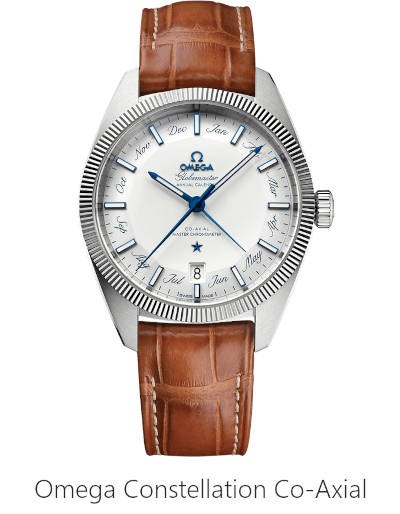
A sleek, modern take on the annual calendar, the Omega Constellation Co-Axial features a sharp dial layout with the month elegantly displayed at 6 o’clock. Its Co-Axial escapement ensures high precision and long-term durability. This model proves that you can have luxury, innovation, and practicality in one sophisticated timepiece.
| Store | Link |
|---|---|
| Ebay | Check it out on Ebay |
5. Perpetual Calendar – The Genius of Mechanical Timekeeping
The perpetual calendar complication is often considered the holy grail of watchmaking. Unlike simpler calendar mechanisms, it accounts for every irregularity in the Gregorian calendar: months with 30 or 31 days, leap years, and even century-year exceptions (until the year 2100). All without requiring any manual correction.
This is mechanical mastery — pure, precise, and poetic.
A Brief History
The concept of the perpetual calendar goes back to the 18th century, first appearing in pocket watches. But it wasn't until 1925 that Patek Philippe introduced the first perpetual calendar wristwatch. Since then, it has remained a symbol of elite horological craftsmanship, blending astronomical calculation with miniature engineering.
Today, perpetual calendars are found not just in six-figure grand complications, but also in surprisingly accessible models thanks to modern manufacturing breakthroughs.
How It Works
Beneath the dial lies a labyrinth of gears, cams, levers, and programmed discs that calculate the length of each month and identify leap years. This intricate system runs in sync with the watch’s timekeeping movement — automatically adjusting the date, day, month, and even year — some even track the moon phase and century.
Who It’s For
This complication isn’t just about utility — it’s about owning a self-contained mechanical brain that mirrors our human-made calendar. Ideal for collectors, connoisseurs, and anyone who appreciates complexity done right.
Fascinating Fact
Most perpetual calendars will remain accurate until the year 2100, when a quirk in the Gregorian leap year rule causes a rare manual adjustment — a small footnote in an otherwise eternal calendar.
Top Watch Pick: Frederique Constant Slimline Perpetual Calendar
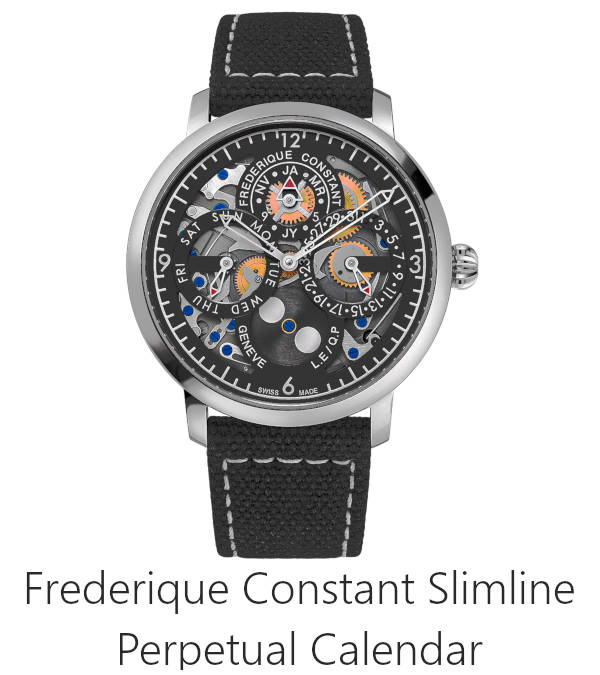
The Frederique Constant Slimline made headlines when it launched as the most affordable Swiss-made perpetual calendar on the market. With its classical styling, ultra-thin profile, and reliable automatic movement, it offers true haute horlogerie at a fraction of the cost — perfect for those stepping into serious watch complications.
Luxury Option: IWC Portugieser Perpetual Calendar
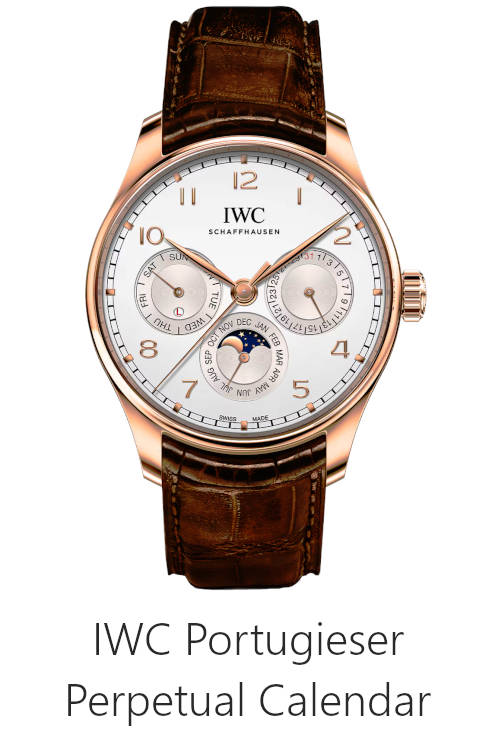
A true mechanical masterpiece, the IWC Portugieser Perpetual Calendar does more than just track the date — it also displays the moon phase, four-digit year, and even synchronizes all calendar elements through a single crown adjustment. Crafted with precision and housed in a statement-worthy case, it's the epitome of engineering elegance.
Both the Frederique Constant Slimline and the IWC Portugieser Perpetual Calendar can often be found at great prices on luxury resale platforms like The Luxury Closet .
6. Easter Date Indicator – A Rare Dance of Astronomy and Faith
Among the rarest and most intellectually fascinating watch complications is the Easter Date Indicator — a mechanism that calculates and displays the shifting date of Easter Sunday, one of the most variable holidays in the calendar.
Unlike fixed dates like Christmas, Easter follows a complex set of rules based on ecclesiastical approximations of lunar cycles and the vernal equinox. Most watches don’t bother with it. But a few horological masterpieces do.
A Curious History
The date of Easter is determined by a formula established at the First Council of Nicaea in 325 AD: it’s the first Sunday after the full moon that occurs on or after March 21. This means Easter can fall anywhere between March 22 and April 25.
Creating a mechanical watch that can compute this date across decades or centuries is not just rare — it’s borderline miraculous.
Only a handful of independent watchmakers have ever attempted it.
How It Works
The mechanism relies on astronomical calculations encoded into a system of cams and gears. It tracks the lunar cycle, aligns it with the spring equinox, and calculates the correct Sunday — a task most modern computers struggle with, let alone a wristwatch.
This complication is typically bundled within a grand complication or perpetual calendar and demands an extraordinary level of craftsmanship, time, and intellect to design.
Did You Know?
Some Easter Indicator watches also calculate other moveable feasts like Ascension Day and Pentecost, which are based on Easter’s date. This creates a full liturgical calendar on the wrist — something no smartwatch dares to offer.
Horology Enthusiast Pick: Andreas Strehler Perpetual Calendar
Andreas Strehler is one of the few living watchmakers capable of creating a mechanical Easter calculation module. His perpetual calendars go beyond standard datekeeping and reflect celestial rhythms with handmade components and microscopic tolerances. It’s not just a watch — it’s a conversation between astronomy, history, and haute horlogerie.
No Affordable Options
The Easter Date Indicator is a pure collector’s complication, only found in ultra-high-end custom or limited production timepieces. If you're lucky enough to see one in person, you're looking at a rare intersection of mathematics, theology, and mechanical genius.
7. Equation of Time – Where Astronomy Meets Timekeeping
The Equation of Time (EoT) is one of the most poetic complications in horology — a function that reveals the difference between solar time and mean (clock) time. While your wristwatch measures time in fixed, 24-hour segments, the actual solar day length varies throughout the year.
This complication elegantly displays that variation, usually as a small sub-dial or scale showing how many minutes the sun is ahead of or behind standard time.
What Is Solar vs. Mean Time?
- Solar time is based on the position of the sun in the sky — it’s noon when the sun is highest.
- Mean time is the uniform time our clocks follow — 24 equal hours every day.
Due to Earth’s elliptical orbit and axial tilt, the sun doesn’t always "pass overhead" at exactly 12:00 PM. Sometimes it’s up to 16 minutes ahead or behind. That’s what the Equation of Time shows.
Horological Heritage
The concept of EoT has fascinated astronomers and watchmakers since the Age of Enlightenment. Early versions of this complication appeared in marine chronometers and astronomical clocks in the 17th and 18th centuries.
Translating this astronomical data into a mechanical watch display is an art few brands attempt — making this one of the rarest and most intellectually satisfying complications in modern horology.
Fascinating Fact
There are only four days in the year when solar time and mean time align perfectly. The rest of the year, the difference — known as the equation — fluctuates.
If you've ever noticed your sundial disagreeing with your watch, now you know why.
Top Watch Pick: Blancpain Villeret Equation of Time
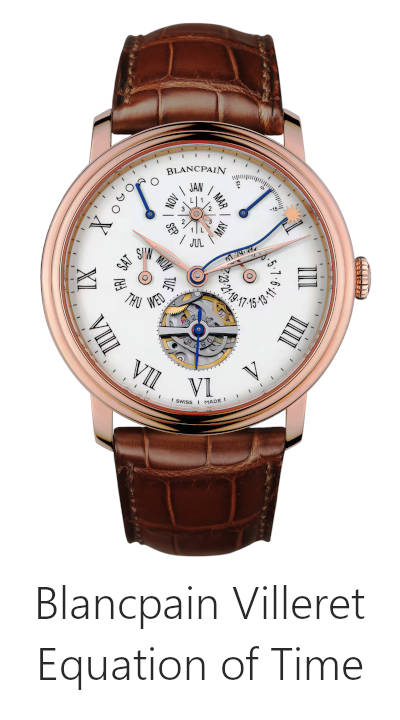
Blancpain, a brand revered for its dedication to traditional watchmaking, offers one of the most exquisite interpretations of this rare complication. The Villeret Equation of Time features an EoT scale, perpetual calendar, and often a moonphase, all wrapped in a beautifully hand-finished case.
A true symphony of celestial mechanics and artisanal luxury.
For Collectors and Dreamers
The Equation of Time isn't a practical feature — it's a celebration of our relationship with the cosmos, a reminder that time, at its core, is an agreement between humans and the heavens.
Frequently Asked Questions About Watch Calendar Complications
What is a watch complication?
A complication is any feature in a watch beyond simple timekeeping. Calendar complications include displays for date, day, month, moonphase, and even astronomical data.
What is the most common calendar complication in watches?
The date display is the most common — it simply shows the day of the month and is found on everything from budget to luxury watches.
What’s the difference between an annual and a perpetual calendar?
- An annual calendar adjusts for 30/31-day months but requires manual correction every February.
- A perpetual calendar automatically adjusts for leap years and varying month lengths — no adjustment needed until the year 2100.
Why are some calendar watches so expensive?
Complications like the perpetual calendar or Equation of Time involve hundreds of precisely engineered parts. These require expert craftsmanship, years of research, and careful assembly — often by hand.
Are there affordable watches with calendar complications?
Yes! Brands like Seiko, Citizen, and Frederique Constant offer reliable calendar watches with excellent value. We’ve included several in this article.
What is the rarest calendar complication?
The Easter Date Indicator is one of the rarest complications in horology. It calculates the shifting date of Easter each year based on lunar and solar cycles — found only in ultra-high-end or custom-made watches.
What are some luxury watches with advanced calendar complications?
Models like the Patek Philippe Grand Complications, IWC Portugieser Perpetual Calendar, and Blancpain Villeret Equation of Time represent the peak of calendar complication mastery.
Conclusion: Time Is More Than Just Hours and Minutes
Calendar complications turn a wristwatch into a miniature mechanical calendar, astronomer, and historian. From the simplicity of a date window to the complexity of a perpetual calendar or Equation of Time, these features tell stories far beyond seconds and minutes.
Whether you're just discovering watchmaking or deep into collecting, calendar complications offer a beautiful mix of functionality, tradition, and mechanical poetry.
Calendar complications range from basic date displays to advanced perpetual calendars that account for leap years and irregular months. These functions are part of a broader world of horological innovation. For an overview of timekeeping complexities, visit Mastering Chronometry: The Top Timekeeping Watch Complications Explained.
Some calendar complications even intersect with astronomical functions, such as moon phases and equation-of-time indicators. To explore these celestial mechanisms in detail, check out Astronomical Watch Complications: A Complete Guide for Collectors and Enthusiasts.
